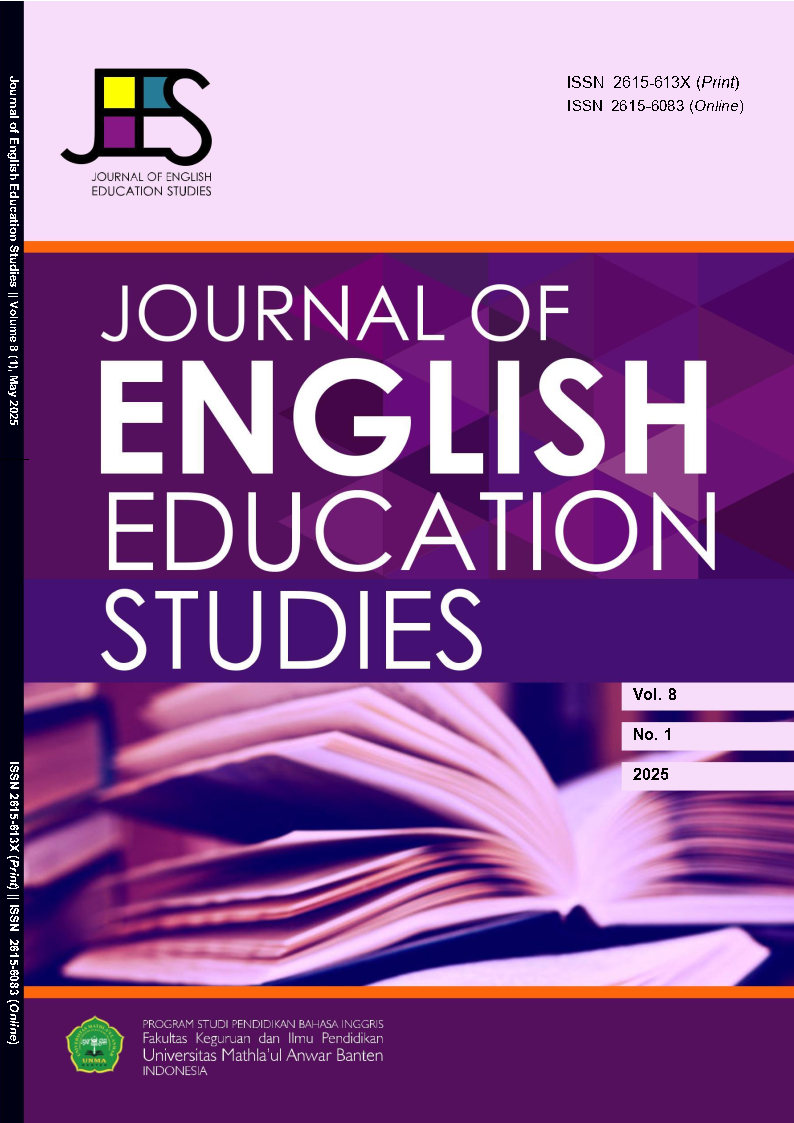Students’ Responses toward Hybrid and Online SPADA UNTIRTA in Teaching ESP for Economic Students at Sultan Ageng Tirtayasa University
Abstract
This study investigates students’ responses toward the implementation of hybrid and online SPADA UNTIRTA in teaching English for Specific Purposes (ESP) to first-semester economics students at Sultan Ageng Tirtayasa University. The research employed a qualitative-descriptive design, combining Likert-scale questionnaire data with open-ended student feedback and classroom observations. Two different learning modalities were compared: a hybrid model that blends face-to-face classroom sessions with asynchronous SPADA activities, and a fully online model that delivers all instruction via the SPADA platform. Findings reveal that students in the hybrid class responded positively to direct interaction with the lecturer, structured learning guidance, and the opportunity for peer collaboration. Meanwhile, students in the online class appreciated the flexibility and independence afforded by the digital platform but also reported challenges such as a lack of real-time feedback and reduced motivation. The results suggest that while both learning modes support student engagement in different ways, the hybrid model is more effective in maintaining interpersonal connection and motivation, while the online model is more suitable for self-regulated learners. These insights underscore the importance of aligning instructional design with learner preferences and capacities. Practical implications include integrating synchronous elements into online courses and providing learner training to optimize the process of delivering ESP materials in hybrid and online models.
References
Alammary, A. (2019). Blended learning models for introductory programming courses: A systematic review. PLoS ONE, 14(6), e0212672.
Alserhan, B. A., Al-Kilidar, H., & Alserhan, Z. A. (2023). Enhancing self-reflection and self-regulated learning in PLEs via LMS: An SEM approach. International Journal of Educational Technology in Higher Education, 20(1), 1–22.
Anderson, T. (2017). Interaction and cognitive engagement in online learning. International Review of Research in Open and Distributed Learning, 18(6), 23–38.
Barz, M., Akcaoglu, M., & Foulger, T. S. (2024). Perceived ease of use and usefulness in technology acceptance and SRL. Computers & Education Open, 5, 100124.
Deci, E. L. & Ryan, R. M. (2012). Self-determination theory: Basic psychological needs in motivation, development, and wellness. Guilford Press.
Fitria, T. N. (2023). English lecturers’ difficulties in teaching English for Specific Purposes (ESP) in various higher education in Indonesia. Journal of English Teaching and Learning Issues, 6(1), 65-80.
Gailea, N., Aisah, S., & La Kariste, R. (2021). EFL students’perception to use SPADA as learning management system (LMS). Proceeding AISELT (Annual International Seminar of English Language Teaching), September, 26 2022.
Garrison, D. R., Anderson, T., & Archer, W. (2000). Critical inquiry in a text-based environment: Computer conferencing in higher education. The Internet and Higher Education, 2(2-3), 87–105. https://doi.org/10.1016/S1096-7516(00)00016-6
Hamer, W., Hakim, R., & Laksono, A. (2022). The perceptions of students on the application of infographics as instructional media in promoting their writing abilities. International Journal of Research in Education, 2(2), 187.
Hamer, W. & Lely, N. L. (2020). The role of SPADA as instructional media and technologies to utilize learners’ self-regulated learning. JEES: Journal of English Education Studies, 3(1), 18–28.
Hamer, W. & Rohimajaya, N. A. (2018). Using flash card as instructional media to enrich the students' vocabulary mastery in learning English. Journal of English Language Studies, 3(2), 167–177.
Hamer, W., Rukmini, D., Saleh, M., & Fitriati, S. W. (2022). The Effectiveness of SPADA UNTIRTA in Promoting Self-Regulated Learning Outcome of the Economic Department Students at Sultan Ageng Tirtayasa University. In International Conference on Science, Education, and Technology (Vol. 8, pp. 328-333).
Hwang, G. J. & Lee, C. Y. (2023). Smart learning environments in language education: A systematic review. Computers & Education, 191, 104659.
Kaptanoğlu, A. E. & Kavanoz, S. (2024). Turkish EFL learners' self-efficacy and self-regulated learning in online contexts. Asian EFL Journal, 26(1), 130–149.
Kizilcec, R. F., Pérez-Sanagustín, M., & Maldonado, J. J. (2017). Self-regulated learning strategies and MOOC success. Computers & Education, 104, 18–33.
Lin, Y., Chen, W., & Pan, C. (2022). Supporting SRL via role-model awareness tools in e-learning platforms. Educational Technology & Society, 25(1), 112–125.
Moore, M. G. (1993). Theory of transactional distance. In D. Keegan (Ed.), Theoretical Principles of Distance Education (pp. 22–38). Routledge.
Murray, N. (2016). Standards of English in higher education: Issues, challenges, and strategies. Cambridge University Press.
Rizki, A., Widiyantoro, S., & Nugroho, A. (2022). SPADA implementation and SRL development in Indonesian higher education. Jurnal Teknologi dan Pembelajaran, 10(2), 211–225.
Sweller, J. (1998). Cognitive load during problem solving: Effects on learning. Cognitive Science, 12(2), 257–285.
Zimmerman, B. J. (2000). Attaining self-regulation: A social cognitive perspective. In M. Boekaerts, P. R. Pintrich, & M. Zeidner (Eds.), Handbook of Self-Regulation (pp. 13–39). Academic Press.
Copyright (c) 2025 Welliam Hamer, Nur Azmi Rohimajaya, Ledy Nur Lely

This work is licensed under a Creative Commons Attribution 4.0 International License.



